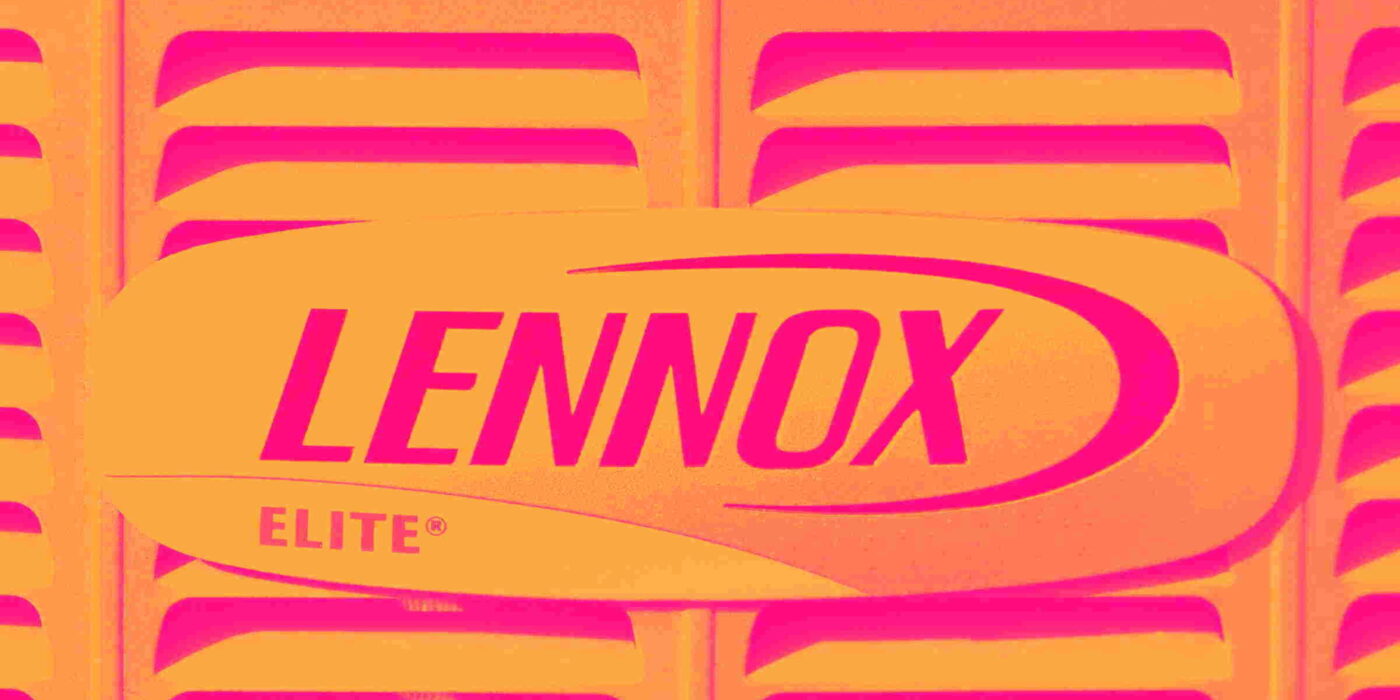
Climate control solutions innovator Lennox International (NYSE: LII) reported Q1 CY2025 results exceeding the market’s revenue expectations, with sales up 2.4% year on year to $1.07 billion. Its non-GAAP profit of $3.37 per share was 3.6% above analysts’ consensus estimates.
Is now the time to buy LII? Find out in our full research report (it’s free).
Lennox (LII) Q1 CY2025 Highlights:
- Revenue: $1.07 billion vs analyst estimates of $1.03 billion (2.4% year-on-year growth, 4.6% beat)
- Adjusted EPS: $3.37 vs analyst estimates of $3.25 (3.6% beat)
- Adjusted EBITDA: $181.2 million vs analyst estimates of $180.4 million (16.9% margin, in line)
- Management slightly raised its full-year Adjusted EPS guidance to $22.88 at the midpoint
- Operating Margin: 14.5%, down from 15.9% in the same quarter last year
- Free Cash Flow was -$61.3 million compared to -$51.8 million in the same quarter last year
- Organic Revenue rose 2.4% year on year (4.2% in the same quarter last year)
- Market Capitalization: $20.36 billion
StockStory’s Take
Lennox’s first quarter results reflected modest sales growth, as the company navigated a period marked by regulatory transitions and shifting tariff dynamics. Management attributed performance to the successful rollout of new low global warming potential (GWP) refrigerant products in both residential and commercial markets, while also contending with increased costs from tariffs and supply chain adjustments. CEO Alok Maskara emphasized the smooth transition to R-454B refrigerant in Home Comfort Solutions and noted that emergency replacement initiatives and inventory management were key operational themes this quarter.
Looking ahead, Lennox’s updated guidance considers higher anticipated inflation from tariffs, offset by recently implemented price increases. Management was clear that while no material volume slowdowns have been observed yet, the outlook is cautious due to external uncertainties such as consumer confidence and the evolving tariff environment. CFO Michael Quenzer indicated that the company’s pricing actions are designed to maintain margin neutrality, while Maskara highlighted ongoing investments in digital capabilities and supply chain flexibility as essential levers for long-term value creation.
Key Insights from Management’s Remarks
Lennox’s leadership outlined the main operational and market factors influencing the first quarter’s results and the company’s strategic response to ongoing industry changes.
-
Tariff-Driven Cost Pressures: Management detailed that higher input costs from direct and indirect tariffs—particularly on steel, aluminum, and China-sourced components—were recognized ahead of pricing actions, leading to a margin decline this quarter. These costs are being mitigated through dual price increases and ongoing supply chain adjustments.
-
Regulatory Product Transition: The shift to new R-454B refrigerant products in both Home Comfort Solutions and Building Climate Solutions segments was a key theme. The transition required manufacturing changes and technician training, which resulted in short-term inefficiencies and order delays, especially in the commercial segment. Maskara described these issues as temporary and largely behind the company.
-
Inventory and Destocking Dynamics: Inventory management played a major role, with the company noting a lack of significant destocking in residential but expecting more pronounced effects in the second quarter. Commercial segment destocking and order timing issues were addressed through increased emergency replacement inventory.
-
Pricing Actions to Offset Inflation: Two price increases—one linked to commodity inflation and another to direct tariffs—were implemented, both with mid-single-digit impacts. Management reported high customer acceptance rates and stated that some surcharges could be reversed if tariff conditions change.
-
Emergency Replacement Initiative: The company’s emergency replacement program in the commercial segment demonstrated early signs of success, with improved inventory positioning and readiness for the upcoming cooling season. Management expects this area to contribute to revenue growth in the coming quarters.
Drivers of Future Performance
Management’s outlook for the remainder of the year is shaped by tariff-related cost inflation, proactive pricing strategies, and execution of product transitions, with a focus on maintaining margin stability amid external uncertainties.
-
Tariff and Price Offset: Higher anticipated cost inflation from tariffs will be addressed through recent and planned price increases, aiming to keep margins stable if external conditions remain unchanged.
-
Product Transition Completion: The full transition to R-454B refrigerant products is expected to reduce manufacturing inefficiencies and order delays, supporting sequential margin recovery, particularly in the Building Climate Solutions segment.
-
Emergency Replacement Growth: The commercial emergency replacement initiative is expected to drive incremental revenue and margin gains as inventory availability and technician readiness improve, mitigating the impact of broader market headwinds.
Top Analyst Questions
- Ryan Merkel (William Blair): Asked about commercial order delays and whether the worst is over; Maskara confirmed order rates improved sequentially and expects remaining inefficiencies to be resolved in the second quarter.
- Tommy Moll (Stephens): Sought clarification on the rationale for revised volume assumptions in both residential and commercial segments; Maskara explained the changes reflect conservatism and anticipation of macroeconomic risks, though no slowdown has been observed to date.
- Jeff Hammond (KeyBanc): Questioned the timing and impact of destocking and tariff-related costs; management attributed the tariff impact to LIFO accounting and expects mitigation efforts to reduce these costs going forward.
- Joe O'Dea (Wells Fargo): Inquired about the breakdown of cost inflation and the flexibility of pricing responses to future tariff changes; Quenzer outlined that roughly half of the increased costs are China-related and surcharges could be adjusted if tariffs are lifted.
- Julian Mitchell (Barclays): Asked about operating margin progression and the interplay between price increases and expected volume declines; management confirmed margins should sequentially improve and explained that price and volume assumptions were conservatively set to balance risk.
Catalysts in Upcoming Quarters
In the coming quarters, the StockStory team will be monitoring (1) the pace and effectiveness of the R-454B product transition and associated margin recovery, (2) the impact of recent price increases on demand and competitive positioning, and (3) progress in expanding the commercial emergency replacement business. Additionally, we will assess how changes in tariff policy or input costs may alter the company’s pricing strategies and volume outlook.
Lennox currently trades at a forward P/E ratio of 24.2×. In the wake of earnings, is it a buy or sell? The answer lies in our free research report.
The Best Stocks for High-Quality Investors
The market surged in 2024 and reached record highs after Donald Trump’s presidential victory in November, but questions about new economic policies are adding much uncertainty for 2025.
While the crowd speculates what might happen next, we’re homing in on the companies that can succeed regardless of the political or macroeconomic environment. Put yourself in the driver’s seat and build a durable portfolio by checking out our Top 5 Growth Stocks for this month. This is a curated list of our High Quality stocks that have generated a market-beating return of 176% over the last five years.
Stocks that made our list in 2020 include now familiar names such as Nvidia (+1,545% between March 2020 and March 2025) as well as under-the-radar businesses like the once-small-cap company Comfort Systems (+782% five-year return). Find your next big winner with StockStory today.




